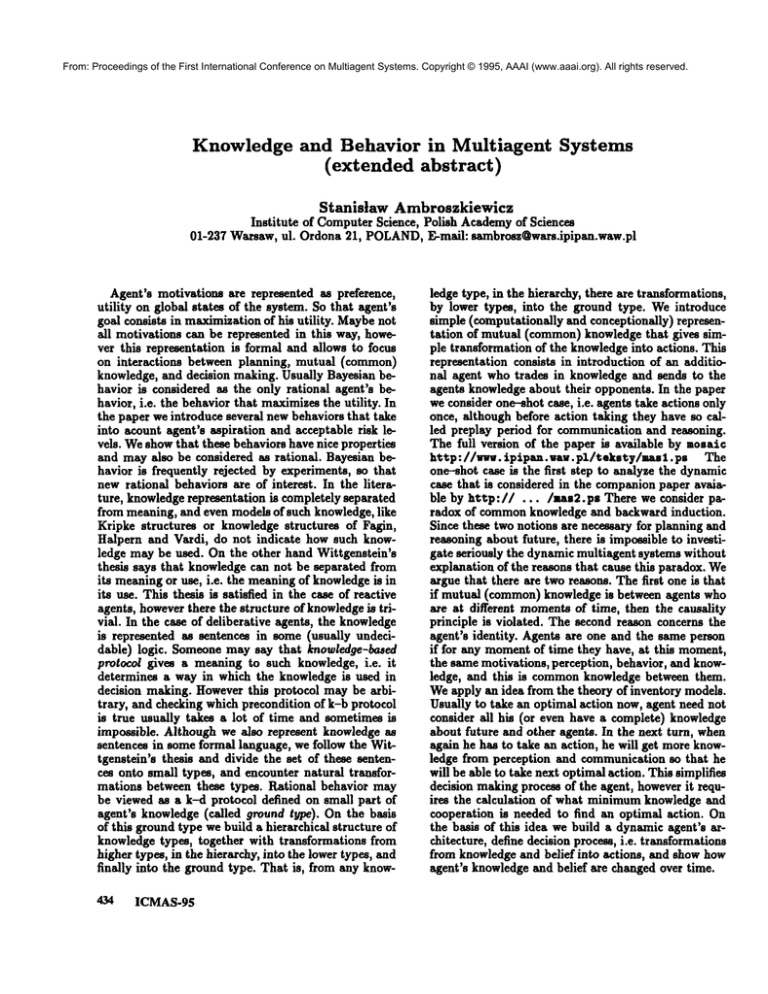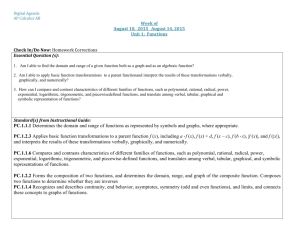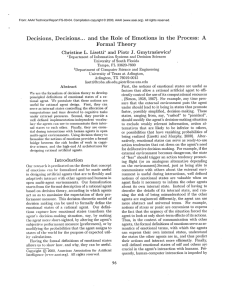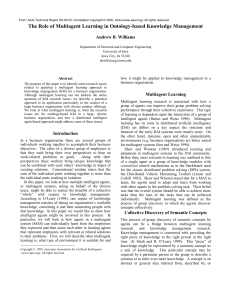
From: Proceedings of the First International Conference on Multiagent Systems. Copyright © 1995, AAAI (www.aaai.org). All rights reserved.
Knowledge and Behavior in Multiagent
(extended abstract)
Systems
Stanislaw Ambroszkiewicz
Institute of ComputerScience, Polish Academyof Sciences
01-237 Warsaw, ul. Ordona 21, POLAND,E-mail: sambrosz@wars.ipipan.waw.pl
Agent’s motivations are represented aa preference,
utility on global states of the system. So that agent’s
goal consists in maximization of his utility. Maybenot
all motivations can be represented in this way, however this representation is formal and allows to focus
on interactions
between planning, mutual (common)
knowledge, and decision making. Usually Bayesian behavior is considered aa the only rational agent’s behavior, i.e. the behavior that maximizesthe utility. In
the paper we introduce several new behaviors that take
into acount agent’s aspiration and acceptable risk levels. Weshowthat these behaviors have nice properties
and may also be considered aa rational. Bayesian behavior is frequently rejected by experiments, so that
new rational behaviors are of interest. In the literature, knowledgerepresentation is completely separated
from meaning, and even models of such knowledge, like
Kripke structures or knowledge structures of Fagin,
Halpern and Vardi, do not indicate how such knowledge may be used. On the other hand Wittgenstein’s
thesis says that knowledge can not be separated from
its meaningor use, i.e. the meaning of knowledgeis in
its use. This thesis is satisfied in the case of reactive
agents, howeverthere the structure of knowledgeis trivial. In the case of deliberative agents, the knowledge
is represented aa sentences in some (usually undecidable) logic. Someone may say that knowledge-based
protocol gives a meaning to such knowledge, i.e. it
determines a way in which the knowledge is used in
decision making. However this protocol may be arbitrary, and checking which precondition of k-b protocol
is true usually takes a lot of time and sometimes is
impossible. Although we also represent knowledge aa
sentences in some formal language, we follow the Wittgenstein’s thesis and divide the set of these sentences onto small types, and encounter natural transformations between these types. Rational behavior may
be viewed aa a k-d protocol defined on small part of
agent’s knowledge (called ground type). On the basis
of this ground type we build a hierarchical structure of
knowledge types, together with transformations from
higher types, in the hierarchy, into the lower types, and
finally into the ground type. That is, from any know434
ICMAS-9$
ledge type, in the hierarchy, there are transformations,
by lower types, into the ground type. Weintroduce
simple (computationally and conceptionaily) representation of mutual (common)knowledge that gives simple transformation of the knowledgeinto actions. This
representation consists in introduction of an additional agent who trades in knowledge and sends to the
agents knowledge about their opponents. In the paper
we consider one--shot case, i.e. agents take actions only
once, although before action taking they have so called preplay period for communication and reasoning.
The full version of the paper is available by mosaic
http://wwg, ipSpan, waw. pl/toksty/mas 1. ps The
one--shot case is the first step to analyze the dynamic
case that is considered in the companionpaper avaiahie by http:// ... /mas2.ps There we consider paradox of commonknowledge and backward induction.
Since these two notions are necessary for planning and
reasoning about future, there is impossible to investigate seriously the dynamic multiagent systems without
explanation of the reasons that cause this paradox. We
argue that there are two reasons. The first one is that
if mutual (common) knowledge is between agents who
are at different momentsof time, then the causality
principle is violated. The second reason concerns the
agent’s identity. Agents are one and the same person
if for any momentof time they have, at this moment,
the same motivations, perception, behavior, and knowledge, and this is commonknowledge between them.
Weapply an idea from the theory of inventory models.
Usually to take an optimal action now, agent need not
consider all his (or even have a complete) knowledge
about future and other agents. In the next turn, when
again he has to take an action, he will get more knowledge from perception and communication so that he
will be able to take next optimal action. This simplifies
decision makingprocess of the agent, however it requires the calculation of what minimumknowledge and
cooperation is needed to find an optimal action. On
the basis of this idea we build a dynamic agent’s architecture, define decision process, i.e. transformations
from knowledge and belief into actions, and show how
agent’s knowledgeand belief are changed over time.





